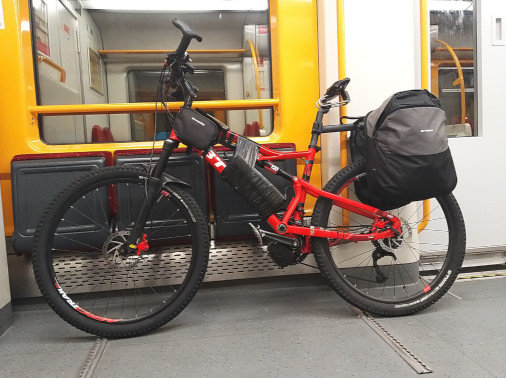casainho
10 GW
- Joined
- Feb 14, 2011
- Messages
- 6,058
I just measure and maybe it can go up to 26mm max. In that case, I would 3D print something to hold it in place or find a creative way to do it.Andrew707 said:I would like to go with your firmware and the features you'd like to implement sounds like a very good idea!casainho said:Then you should go with our OpenSource firmware that has high efficiency when compared to other firmware. I would go with a 250Wh battery and with our firmware you can fine tune directly on display for long travels to optimize range, also battery SOC with very good estimation that includes the parameter of battery internal resistance. 250Wh battery is pulling 250W during one hour and maybe you will only pull about 75W average per hour, so, enough for 4 hours ride - or you can have an extra 250W battery to use on the long travels and for daily riding use only one.
For display I would go with SW102 because is very small and cheap and looks cheap also, without much value.
I just checked my dropbars diameter and it's 31.8mm while looks like SW102 is only 22.2mm. Do you think the clamp would still fit with a longer screw? SW102 screen looks really stealth, I like it!
Andrew707 said:Talking about the batteries I probably forgot to mention where I'm planning to use my bike is a very hilly area. Constantly up and down, up and down. I'm not sure if 250Wh would be enough. I already used a hub motor with two LiGo batteries which were almost 200Wh and they were okay for shorter rides but not an option for a bikepacking. Ideally, I would like to have around 50km of range. That's why I was thinking about either 36V 16.5Ah or 48V 16.5Ah battery because looks like they are a good capacity to price ratio (e.g. the same capacity LiGo batteries would cost twice as much).
50 kms range? -- let's compare:
You say you are pretty fit and I weight 105kgs with 173cms, I am far from fit. My bicycle is this one, tires 2.2:

Recently a did a trip of 43kms and used 166Wh (36%) of my 460Wh battery (that has with 200 milliohms resistance):


This trip was done half in road and other half on gravel, on flat roads near the ocean. And my average pedal human power was about 150Wh. Since you are pretty fit compared to me and probably have a bicycle with slim tires, I would say you would use less than the 166Wh I used - now the question is how many hills you will get on that 50kms trips?
I usually record the power I use for trips so I can optimize the battery I will take on next trip. One of the last MTB trip, with the same bicycle as you see on the picture (including the rear panniers), 45kms and +1400m, I took about 5h and I used only 320Wh. So, since you are very fit compared to me and probably with a bicycle with slim tires, I would say a 250Wh battery would be enough for your 50 kms bikepacking trips.

Note that the very latest firmware version was optimized to use low power at values like below 150W - torque sensor has 4x more sensitivity and in addition the motor current is controlled with 4x more resolution.
For bikepacking and having a small and light battery pack, I would go with cells that have high capacity like 18650 I use with 3600 mAh but they have high internal resistance which is not a issue when pulling low current / power, which will be the case anyway for the long trips.
For a 36V motor, maybe you could go with a 10S2P battery pack: 3.6 amp each cell * 3.7 volts each cells * 10 cells in series * 2 parallel = 266Wh. This battery pack would need to be hand made (my were done on a local shop, mainly soldering the tabs and then I wired the BMS and put tape with insulating spongy plastic) and would be half in size of that one of 36V 16.5Ah you did mention.
About the gear, the blue gear is very robust when your use our OpenSource firmware that has a feature to limit the current ramp / motor current torque ramp and this saves a lot this gear. The metal one is clearly more noisy and heavy.
The magnetic brake sensors are very easy to install and you do not have them, you will have serious risk to damage the blue gear!!
About the drag, I would keep using always the motor assisting since you can have a very small and light battery and configure to use the motor max power, like you can quick configure on the display main screen the max power of 25, 50, 75 or more Watts and that will probably compensate the drag.
See the TSDZ2 wiki FAQ here for all information: https://github.com/OpenSource-EBike-firmware/TSDZ2_wiki/wiki/FAQ


